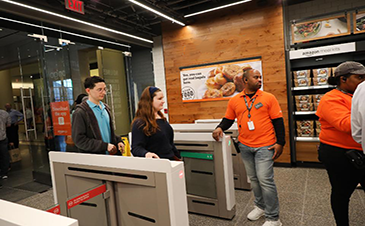If consumers can get what they need from the convenience store and leave without contacting the cashier, how cool is that?
Since 2015, Amazon has been trying this idea. It is now ready to open a retail store in Seattle, promising to provide convenient online shopping in the real world.
For a technology that most people are familiar with but not thinking about, this will be a huge win.
Go Grocery is a store created by Amazon for people in a hurry. This is a 10,400 square foot store with department stores, baked goods, agricultural products, beverages and easy-to-cook meals.
This is a small, centralized grocery store that consumers can find in the corner of city blocks. In addition to the Amazon brand, the uniqueness of this store also lies in the convenience of its new era.
Amazon is known for its customer service, which has helped this online retailer become one of the most trusted and loved brands in the United States.
Store managers understand that consumers do not want to understand the technology, they just want the problem to be solved. Consumers want convenience, and this is what they get in the Amazon store.
The customer enters Go Grocery, scans the QR code connected to their Amazon account, selects the required items, and then leaves. All payment details and product tracking are processed in the background through a cloud-based payment infrastructure and a large number of cameras.
Amazon said that self-driving cars use the same types of technology (including machine vision, sensor fusion, and deep learning), making it possible to realize the “Just Walk Out” shopping experience.
This way of shopping is too cool, but what if consumers do n’t shop on Amazon? Other retail business models are trying to use RFID to replicate this experience.
RFID tags have been in existence since they were invented by Harry Stockman in 1948. Today, from subway passes to livestock tracking, micro RFID tags are widely used.
RFID tags can be attached to product labels and stickers because of their small size. It is superior to simple bar codes because many RFID tags can be scanned at the same time. These tags are also very effective in inventory management systems.
Avery Dennison is known for manufacturing labels used in the consumer goods and packaging industries. Recently, the California-based company has actively expanded its RFID business.
In November last year, it acquired Smartrac, the world’s largest RFID tag inlay manufacturer. A month later, Avery Dennison broke ground on its new manufacturing plant in Brazil. Avery Dennison currently holds more than 1,000 RFID patents and fully utilizes its relationship with leading consumer brands.
In November 2019, Avery Dennison began a pilot project in collaboration with Ralph Lauren. According to a report published by Women’s Wear Daily, all labels printed on shirts, pants and other clothing will contain a electronic label. These tags provide a digital identity for clothing, which can track inventory and provide better after-sales service.
The advantages of RFID also make it suitable for convenience stores. Items can be marked and read in batches. This means retailers only need to scan once to know exactly how many items are on the shelves. This reduces the labor costs associated with inventory counting and repackaging.
Amazon wins online retail business through contactless shopping. And Avery Denison is manufacturing digital products to enable contactless shopping in the real world.



发表评论
Want to join the discussion?Feel free to contribute!